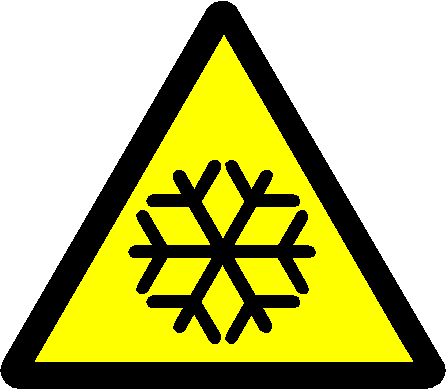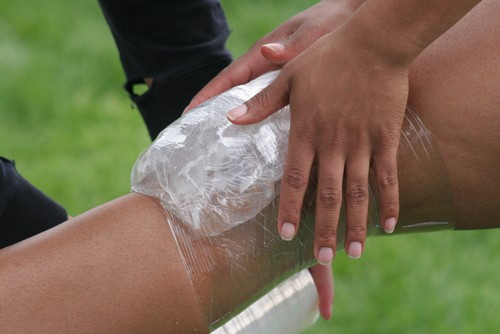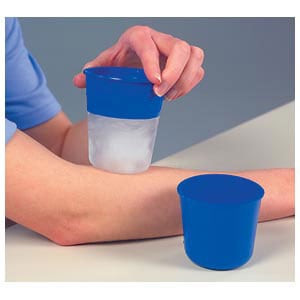By Ross Ashcraft
Cryogenics is a term we hear in science fiction. In these stories, someone freezes their head for the future generations to bring back to life. Believing in some future medical breakthrough, others will place themselves inside cryopods in hopes that the alien overlords  will revive them. However farfetched many of these ideas might be, the power of cold to help in the medical field is well documented. Cryotherapy is used in many medical practices and is one of the most powerful tools at a massage therapist’s disposal.
will revive them. However farfetched many of these ideas might be, the power of cold to help in the medical field is well documented. Cryotherapy is used in many medical practices and is one of the most powerful tools at a massage therapist’s disposal.
When we are injured, one of the body’s initial responses is to cause inflammation in the area. Inflammation is blood pooling and possibly stagnating in the area as a protection response. This initial inflammation can be controlled and the healing process sped up with a simple application of cold. A common way to remember what to do during an acute injury is it to use the acronym I.C.E. This acronym stands for Ice, Compression, and Elevation.
 In addition to controlling inflammation, cold applied at the site of injury will also increase the body’s healing response. When cold is applied to an area, the site of application undergoes what is called vasoconstriction a.k.a. the blood vessels shrink. This is how we can control inflammation. However, after several minutes of cold application, the body will feel itself getting TOO cold and then reverses its response to the cold. It will now rush extra blood to the area with vasodilatation a.k.a. the blood vessels expand. This phenomenon is called the Hunting Response.
In addition to controlling inflammation, cold applied at the site of injury will also increase the body’s healing response. When cold is applied to an area, the site of application undergoes what is called vasoconstriction a.k.a. the blood vessels shrink. This is how we can control inflammation. However, after several minutes of cold application, the body will feel itself getting TOO cold and then reverses its response to the cold. It will now rush extra blood to the area with vasodilatation a.k.a. the blood vessels expand. This phenomenon is called the Hunting Response.
With continual application of cold over several minutes, the body will flip flop between vasoconstriction and vasodilatation. Simply put: more blood freely flowing through the area equals faster healing. After the inflammation is under control you can use the ice therapy to create maximum healing response. Apply ice for 10 minutes, take it off for 10 minutes, replace it for 10 minutes. Rest for a period and then start the process over.
Cryotherapy Techniques
To be safe and effective, always palpate the site of treatment before, during, and after the application of cold.
 Ice Massage:
Ice Massage:
Directly applying cold or ice to an area can create profound change. Place cold on an area until numbness has occurred on the skin. If you choose to apply ice directly and without a barrier on the skin, I recommend you rub the ice into the area as opposed to resting it on the site. You’ll know the area is numb if they can’t feel you tapping the skin. Immediately apply any massage technique and watch knots and tension slip away.
Contrast Method
Obtain one cold pack and one hot pack. Place the cold pack on the site of tension. Leave in place for about 5 minutes. Place the hot pack on the site. Leave in place for about 5 minutes. Massage the area and feel the profound differences generated in the muscle and fascia layers with this technique.
Simultaneous Contrast Method
The single most powerful method in the use of ice in massage therapy is the use of the simultaneous contrast method. Obtain one cold pack and one hot pack. Place the cold pack on the site of discomfort and place the hot pack below it. Work on another part of the body for a few minutes and then switch the packs. Work on another body part and switch the packs. Keep doing this until you are ready to massage that original body part. The change is typically profound and well worth the discomfort. In addition, the amount of manual work required by the therapist to bring relief to the client will dramatically diminish.
 Cryokinetic Challenge: Get an ice cube, wrap it in a paper towel while leaving one edge exposed. Rub the ice cube into a single tender muscle on your body. I would suggest either the muscles of your thumb or the muscles on the outside/lateral side of your forearm. Rub the area in a circular
Cryokinetic Challenge: Get an ice cube, wrap it in a paper towel while leaving one edge exposed. Rub the ice cube into a single tender muscle on your body. I would suggest either the muscles of your thumb or the muscles on the outside/lateral side of your forearm. Rub the area in a circular pattern until the skin is numb. Once the area is numb move that body part all around i.e. use the muscles under the skin you just made numb. Let us know what changes you experienced.









